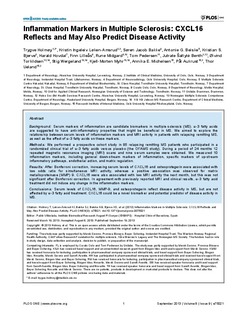| dc.contributor.author | Holmøy, Trygve | |
| dc.contributor.author | Løken-Amsrud, Kristin Ingeleiv | |
| dc.contributor.author | Bakke, Jacob | |
| dc.contributor.author | Beiske, Antonie Giæver | |
| dc.contributor.author | Bjerve, Kristian S | |
| dc.contributor.author | Hovdal, Harald Olav | |
| dc.contributor.author | Lilleås, Finn | |
| dc.contributor.author | Midgard, Rune | |
| dc.contributor.author | Pedersen, Tom | |
| dc.contributor.author | Saltyte Benth, Jurate | |
| dc.contributor.author | Torkildsen, Øivind | |
| dc.contributor.author | Wergeland, Stig | |
| dc.contributor.author | Myhr, Kjell-Morten | |
| dc.contributor.author | Michelsen, Annika | |
| dc.contributor.author | Aukrust, Pål | |
| dc.contributor.author | Ueland, Thor | |
| dc.date.accessioned | 2015-11-20T11:02:30Z | |
| dc.date.accessioned | 2016-06-02T12:20:37Z | |
| dc.date.available | 2015-11-20T11:02:30Z | |
| dc.date.available | 2016-06-02T12:20:37Z | |
| dc.date.issued | 2013 | |
| dc.identifier.citation | PLoS ONE 2013, 8(9) | nb_NO |
| dc.identifier.issn | 1932-6203 | |
| dc.identifier.uri | http://hdl.handle.net/11250/2391228 | |
| dc.description.abstract | Background: Serum markers of inflammation are candidate biomarkers in multiple sclerosis (MS). ω-3 fatty acids
are suggested to have anti-inflammatory properties that might be beneficial in MS. We aimed to explore the
relationship between serum levels of inflammation markers and MRI activity in patients with relapsing remitting MS,
as well as the effect of ω-3 fatty acids on these markers.
Methods: We performed a prospective cohort study in 85 relapsing remitting MS patients who participated in a
randomized clinical trial of ω-3 fatty acids versus placebo (the OFAMS study). During a period of 24 months 12
repeated magnetic resonance imaging (MRI) scans and nine serum samples were obtained. We measured 10
inflammation markers, including general down-stream markers of inflammation, specific markers of up-stream
inflammatory pathways, endothelial action, and matrix regulation.
Results: After Bonferroni correction, increasing serum levels of CXCL16 and osteoprotegerin were associated with
low odds ratio for simultaneous MRI activity, whereas a positive association was observed for matrix
metalloproteinase (MMP) 9. CXCL16 were also associated with low MRI activity the next month, but this was not
significant after Bonferroni correction. In agreement with previously reported MRI and clinical results, ω-3 fatty acid
treatment did not induce any change in the inflammation markers.
Conclusions: Serum levels of CXCL16, MMP-9, and osteoprotegerin reflect disease activity in MS, but are not
affected by ω-3 fatty acid treatment. CXCL16 could be a novel biomarker and potential predictor of disease activity in
MS. | nb_NO |
| dc.language.iso | eng | nb_NO |
| dc.publisher | Public Library of Science | nb_NO |
| dc.rights | Navngivelse 3.0 Norge | * |
| dc.rights.uri | http://creativecommons.org/licenses/by/3.0/no/ | * |
| dc.title | Inflammation markers in multiple sclerosis: CXCL16 reflects and may also predict disease activity | nb_NO |
| dc.type | Journal article | nb_NO |
| dc.type | Peer reviewed | nb_NO |
| dc.date.updated | 2015-11-20T11:02:30Z | |
| dc.subject.nsi | VDP::Medisinske fag: 700::Klinisk medisinske fag: 750::Nevrologi: 752 | nb_NO |
| dc.subject.nsi | VDP::Midical sciences: 700::Clinical medical sciences: 750::Neurology: 752 | nb_NO |
| dc.source.volume | 8 | nb_NO |
| dc.source.journal | PLoS ONE | nb_NO |
| dc.source.issue | 9 | nb_NO |
| dc.identifier.doi | 10.1371/journal.pone.0075021 | |
| dc.identifier.cristin | 1070201 | |
| dc.description.localcode | © 2013 Holmøy et al. This is an open-access article distributed under the terms of the Creative Commons Attribution License, which permits unrestricted use, distribution, and reproduction in any medium, provided the original author and source are credited. | nb_NO |

